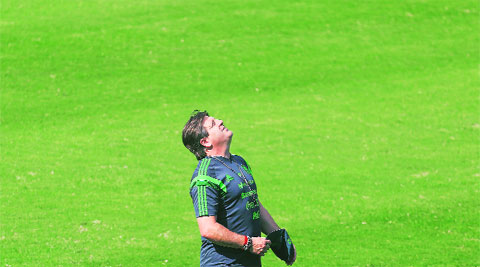How Mexico came to party
 Mexico’s coach Miguel Herrera during a training session at the Rei Pele training center in Santos city. (Source: Reuters)
Mexico’s coach Miguel Herrera during a training session at the Rei Pele training center in Santos city. (Source: Reuters)Javier Hernandez, the Manchester United striker and easily the biggest name in Mexico, had just scored the most important goal of his life.
And Mexico’s World Cup campaign. Having rustled the Croatian net with his header from close range in Mexico’s final group game, ‘Chicharito’ had assured his country of a berth in the knock-outs to face his future United boss Louis van Gaal’s invincibles, Holland.
So, in celebration, he darted towards the herd of bibbed photographers behind the corner flag and slid down on his knees, perhaps knowing that the pose would make the front page of every Mexican newspaper the following day. Only, it didn’t, as almost every zooming lens was focussed solely at the other end of Arena Pernambuco.
There, on his belly, lay Miguel Herrera — a short, fat man dressed in an oversized suit — trying to breathe, yell and plant a kiss on his goalkeeper’s cheek all at once. Then he rose pink-faced, thrust out his pelvis for the benefit of the cameras and heaved his body back to his designated coaching spot in front of his dug-out.
Forget Mexico, Herrera’s pelvic-thrust made most front pages in Brazil — it would’ve made all had Brazil not qualified on the very day. ‘Cara — Copa do Mundo’ read one headline, roughly translated as ‘Face of the World Cup’. Another paid tribute to his never-say-die personality with a Mexican word. ‘GUERRERO’, it said in bold letters. In English, guerrero means warrior.
The warrior’s identity
In Mexican popular art, the warrior is supposed to be a faceless man, a masked crusader, who veils his emotions in silver foil till the day he dies. Sometimes, even after that. As a sign of ultimate respect, the best luchadors are lowered into their coffins with their face-covers still tightly knotted to the back of their lifeless skulls.
That mask is their identity, a protector of their soul — one that is only shamefully removed in public when a warrior falls from grace. In late 2013, perhaps to atone for his past sins — he admits to committing plenty, such as head-butting Honduras’ Dolmo Flores and faking injury himself — Herrera’s face was publicly revealed to Mexico. The country is said to have cringed at first sight.
The face was square, chunky and symbolised pure failure. Herrera, 46, was once a national footballer with limited success. Now, he had the unenviable task of lifting El Tri — Mexico’s national side — from the depths of disgrace and into the World Cup at the fag end of a woeful qualifying campaign.
Few gave him a chance. Not when his three predecessors — Jose Manuel de la Torre, Luis Fernando Tena and Victor Manuel Vucetich (in chronological order) — had failed and been fired in the space of a month. Not when Mexico’s hopes were linked with the USA, who needed to beat Panama to keep their southern neighbours alive in the first place.
“We will owe them (USA) if they do it,” said Herrera in his first press conference, before winking and slyly adding: “But they owe us more. They owe us for California.”
All of Mexico smiled. Then they began to hope again as USA, down 1-2, scored twice in stoppage time against Panama to send Mexico into the play-offs against New Zealand.
Man of the hour
When Herrera inspired his men to a 9-3 aggregate win against the Kiwis to help Mexico storm into Brazil through a fast closing backdoor, a country collectively believed that a man called El Piojo (The Louse) was indeed their man of the hour. Three games into what has been an excellent campaign, Herrera is being hailed as something bigger. Messiah, the fans call him.
“Without him, we wouldn’t have beaten Cameroon in the opening match,” says Jose ‘Pepito’ Ferreira, a fan from Mexico City.
“When the first two goals of your World Cup are disallowed (‘scored’ by Giovani dos Santos) and you can’t beat the weakest team in Brazil, it is very easy to give up.”
“But we don’t give up. Winners know how to pull themselves off the mat,” Herrera said after Oribe Peralta scored the decider late in the second half.
Rafael Marquez, Mexico’s captain for his fourth successive World Cup, claims that this attitude has plenty to do with Herrera. “This has been the best Mexico side I have been a part of and that has something to do with Piojo,” the former Barcelona player said. “He doesn’t just want to win. He wants us to make history. That kind of belief from a manager is rare.”
splashed All over
Rarer still, is for a team to hold Brazil to a draw in their backyard, which Herrera’s Mexico achieved in their second game. Rarest, as far as El Tri are concerned, is scoring a goal in the final group game of the World Cup. Not since 1986 had Mexico scored one. Against Croatia, they slotted in three. “I’m glad all the credit is going to Piojo and everyone is talking about him now,” Marquez later said.
Herrera is literally everywhere now. On the forefront of van Gaal’s mind and in the Mexican fan’s heart. Travelling fan Pepito, for one, is a believer. Like many, he dresses up as a luchador before attending Mexico’s game. Only, instead of a silver foil, he veils his face with a Miguel Herrera mask —the modern-day veil of a Mexican warrior.





